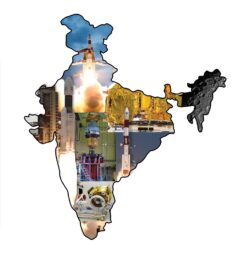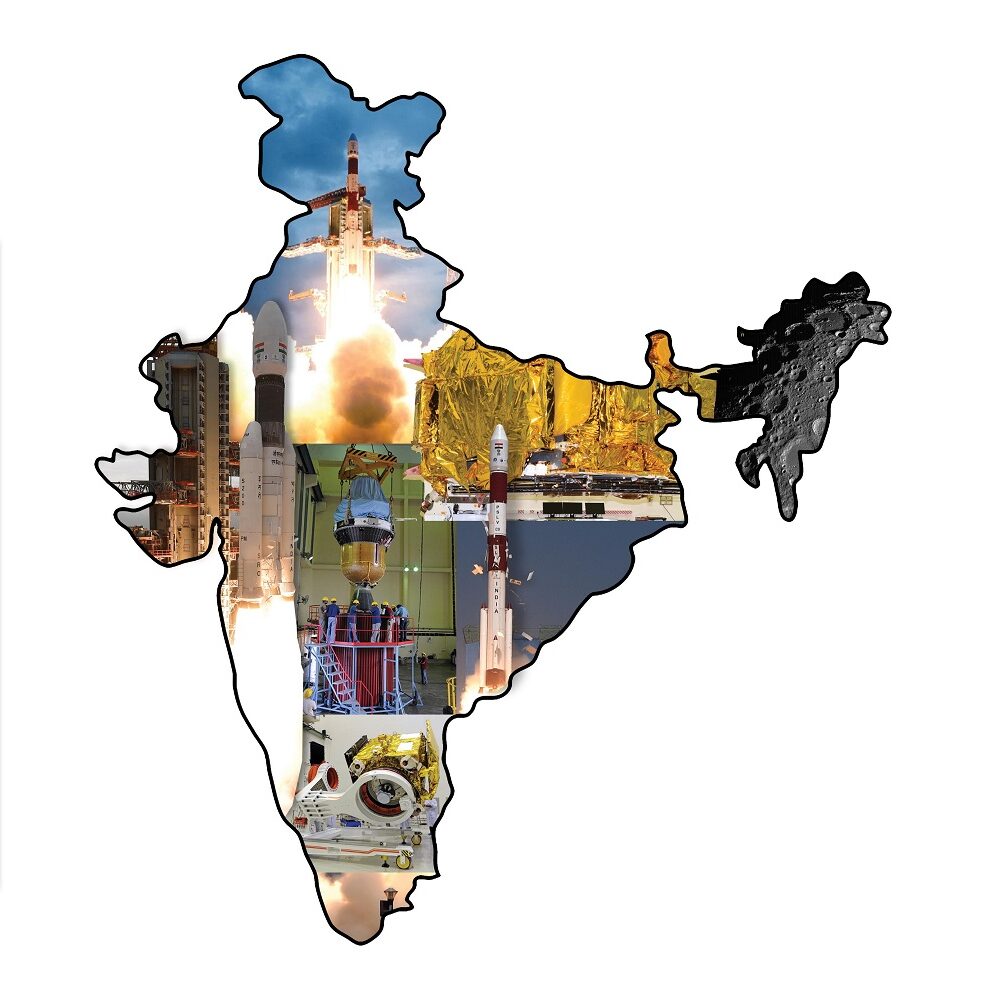The Indian space ecosystem is transforming. Public sector space programs are orienting toward exploration, commercial space endeavors are proliferating, national space policy is shifting, and the students who will carry India to new achievements in space are increasingly looking to opportunities in science, technology, engineering and mathematics (STEM).
There remain significant obstacles for India to realize its full potential, but there is reason to think the country is on the cusp of overcoming them and entering a new era in its long history in space.

AMBITIOUS GOALS AND AN ILLUSTRIOUS HISTORY
India’s journey in space began in 1962, just 15 years after gaining independence from the United Kingdom. In the time since, the country’s space agency, the Indian Space Research Organisation (ISRO), has achieved feats uncommon among nations, including developing two indigenous launch systems and building satellite constellations for a variety of applications.
As an example, ISRO’s geospatial tools are being used today to help track COVID-19 infections and inform the public as well as study how the pandemic is impacting daily life like air and water quality. This is in keeping with how ISRO has traditionally viewed space endeavors — using space access and assets for benefits on Earth. From the beginning, India’s journey in space has been focused on providing Earthly benefits, though public awareness of this virtuous intent is a more recent development.
“Indians are very proud of ISRO,” said Shreya Santra, a Ph.D. candidate in space robotics and member of the Space Generation Advisory Council. “There were critics in the 1990s. Why do we need to spend so much money for space when many people are dying of hunger? But now, there is a social awareness of the scientific benefits, such as in disaster response and urban planning.”
Bolstered with this popular support, ISRO is broadening its mission areas. Santra said that ISRO is shifting from using space assets primarily for Earth application and looking toward planetary exploration, space sciences, and human space flight research. The pace of these missions is accelerating.
In 2008, ISRO sent the lunar orbiter and impactor Chandrayaan-1 to the Moon. In 2014, the successful Mars Orbiter Mission made India the fourth nation to orbit the Red Planet. And while the 2019 Chandrayaan-2 mission was only partially successful when a lander and rover failed to make a soft landing on the Moon, it nevertheless underscored ISRO’s intent to reach farther into space.
Indeed, India is one of the few nations with the domestic technology and infrastructure needed to independently accomplish such bold and challenging endeavors.
Looking ahead, ISRO is building out its human space flight program and recently reached a cooperation agreement with the French National Space Agency (CNES) to provide access to French training and space technologies. As that proceeds, ISRO is planning to launch a Venus orbiter in 2024, a space station in 2030, and a third lunar exploration mission, Chandrayaan-3.
Relative to other major space-faring nations, India’s budget for civil space activities is modest, about $1.9 billion, according to The Space Report. Yet, that is a 141% increase since 2010, which in part reflects a national ambition to have the Indian space sector contribute 1% to a target $5 trillion GDP by 2024. The Indian space economy is currently worth $7 billion, and India aspires to grow that to $50 billion. Doing so will require a thriving commercial space sector, and there too India is in a period of transformation.
THE EMERGENCE OF INDIA’S COMMERCIAL SPACE SECTOR
ISRO has historically relied on domestic enterprise to provide components for launch systems, satellites and other space infrastructure. Some 80% of the ISRO’s Polar Satellite Launch Vehicle (PSLV) production is conducted by private industry, as reported in a PwC study, and for the Mars Orbiter Mission, more than 120 companies supported manufacturing.
However, the intellectual property (IP) for these and other programs is owned by ISRO. Indian businesses that supply materials have a reliable customer in ISRO, but they are challenged to sell goods to other organizations — the products they fabricate are useful primarily for the Indian space program. This is beginning to change.
“What is happening in India today is what happened in the U.S. 40 years ago,” said Dr. Narayan Prasad, COO of Satsearch. “The new companies in the last few years are making policymakers think about what is this space landscape and how can we turn this into a commercial opportunity for Indian companies to compete globally, rather than looking at space as a sovereign capability or R&D program with applications that are strictly societal.”
In May 2020, Union Finance Minister Nirmala Sitharaman announced a policy shift allowing private space companies to access ISRO facilities and services. Sitharaman said in part, “A lot of individuals and startups have spent a lot of time developing space-related technologies. Unfortunately, because of Indian regulations, they are unable to use ISRO facilities for even testing their products. To provide a level playing field in satellite launches and space-based services, we will make a provision for the private sector to benefit from the assets which are available to ISRO and for India to benefit from it.”
Sitharaman also said the intention is to “provide a predictable policy and regulatory environment to private players.” This is perhaps the more important component of the policy shift.
“The present government has been trying to introduce a lot of new things that haven’t happened yet,” said Santra. “[They are] trying to privatize a lot of things, encourage youngsters to come up with startups and innovation. It’s a great decision but is not yet translated into action. They introduced some new regulations, but there is no national space policy yet to give an explicit explanation of how they’re going to do it.”
Currently, there are two organizations focused on transferring and promoting ISRO technologies and products to the commercial sector. Antrix Corporation, controlled by the Indian Department of Space, markets ISRO products and services. New Space India Limited was stood up in 2019 to supply ISRO products and services to global customers. However, ISRO does not outsource space services to the private sector, which would yield space technology IP and infrastructure that companies could sell to other customers, such as components of the Indian government or businesses and organizations around the world.
“New space companies are not looking at ISRO as a customer,” said Prasad. “They are looking upstream and downstream to create capacity by investing in IP. This is where you see a radical shift. They have chosen to build IP on their own, and they don’t have contracts with the space agency.”
Examples include Skyroot Aerospace and Agnikul Cosmos, both of which are developing launch systems independent of ISRO. While entrepreneurs and innovators consider their role in the Indian and global space ecosystem, one challenge is that the available Indian venture capital for space companies is somewhat limited, inevitably pushing new companies to either solicit funding from large Indian corporations that are not involved with space or look abroad for foreign investors. At this point, there is not a large appetite in terms of foreign direct investment commensurate with other Indian sectors, said Prasad. How can this transitional state be moved forward?
“There are only two ways we can break this cycle,” said Prasad. “One is to open up [government] end users directly to the private sector so they can service requirements directly. Two is to ask the space agency to come up with a procurement mechanism for procuring services. They become the administrator of the procurement and then do R&D work only and not focus on production that industry can do.”
As India’s space community evolves and expands, a critical asset is needed: a reliable pipeline of skilled talent.
BUILDING INDIA’S HUMAN SPACE INFRASTRUCTURE
India’s 11th president, who also led the development of the first launch system, Dr. A. P. J Abdul Kalam said, “The ignited mind of the youth is the most powerful resource on the Earth, above the Earth and under the Earth.”
In this, the future of India’s space ecosystem is bright. More than half of India’s population is younger than 25, some 600 million people, the most of any nation. For India’s space ambition, the imperative is to cultivate in young people an interest in and aptitude for STEM subject matter.
In the 1990s, the “IT boom” drove demand for engineers, technologists and business management, which in turn led to growth in IT engineering education, according to a Vivekananda International Foundation study on India’s STEM education capacity. The consequence of this, however, was that investments in education for basic science and mathematics diminished, and there were far fewer students pursuing education in these areas that are fundamental in the space ecosystem and workforce. The result, the VIF study said, was that “the culture of research and innovation was worst hit.”
Here too India is at an inflection point. A 2009 law established a pathway for developing universal elementary education, and the National Education Policy 2020 expanded and defined India’s education goals. From foundational learning to higher education, the policy includes objectives for reaching underprivileged, underrepresented groups, driving interest and knowledge in emerging technologies like AI and machine learning, and critically, training and supporting teachers.
One opportunity for India is using the collective pride in ISRO accomplishments and the fascinating future in space as a hook for inspiring student interest in STEM subjects. Space Foundation is working to support this through our Teacher Liaison program, which equips teachers with the resources and training to help their local peers develop space-themed curricula that enhances STEM learning. There are currently 38 teacher liaisons in India training and helping educators use space to support students as they consider their place in India’s changing space ecosystem.
Looking ahead, India has all of the pieces of the puzzle to transform its future in space. As national investments, commercial activity, and student successes grow, India will emerge as a powerful leader in the 21st century space ecosystem. It is heartening that such a bright future comes with a long tradition of accessing space to improve life on Earth.
Shelli Brunswick is the Chief Operating Officer of Space Foundation.
This article originally appeared in the May 2021 issue of SpaceNews magazine.
